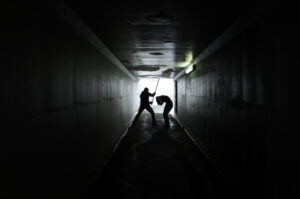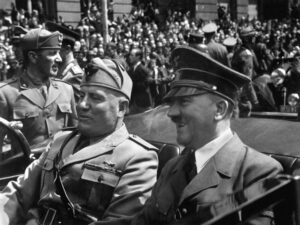This tornado claimed 114 lives, injured 230 others, and caused damage equal to $50,000 in 1902 dollars.
The Goliad Tornado struck the town of Goliad, Texas, on May 18, 1902, touching down on the south side of the San Antonio River at 3:35 P.M. It claimed 114 lives, injured 230 people, and caused damage equal in value to $50,000 in 1902 dollars. It is considered to be one of the two most destructive tornadoes in the history of Texas, the other being the Waco strike of 1953. Of the 114 deaths, fifty were members of an African-American Methodist church who died when their church was destroyed.
This tornado sounded like a heavily loaded freight train. The northwest section of the town saw an area one-mile-long and half a mile wide, totally wiped out and one hundred homes lost. The dead were buried in one long trench, for there was no time to dig separate graves or conduct individual funerals. Following the disaster, the Goliad County Courthouse served as a temporary hospital and morgue.
The town of Goliad is built around its courthouse a building designed by Texas architect Alfred Giles and erected in 1894. Limestone was used in the construction, hauled from Austin by oxcart. The courtyard was enlarged and restored in 1964. Along with the nineteenth and early twentieth century structures surrounding it the courthouse was entered on the National Register of Historic Places in 1976. Goliad today is primarily based on oil, agriculture, and cattle, but tourism is also a vital component.
The moderate climate provides habitat for a variety of wildlife and rich grasslands for ranching. Landscape is an important historical resource, from the plants and animals that thrive there to modern day roadways that follow centuries-old trade routes. Giant oak trees dominate the land cover, traditionally used for grazing herds of cattle and horses. The San Antonio River flows through the town. On the north lawn of the courthouse there is a tree called “The Hanging Tree.” At various times between 1846 and 1870, this tree served as the site of court sessions. Death sentences pronounced by the court were carried out immediately with a rope and a strong limb. During the 1857 Cart War, in which Texan freighters perpetrated a series of vicious attacks against Mexican cart drivers along the Indianola-Goliad-San Antonio Road, this site witnessed a number of unauthorized executions before the conflict was brought to an end by Texas rangers.
By the early eighteenth century, when Spanish missionaries and soldiers arrived in the mid-coastal area of Texas, they found the native peoples as longtime residents of the area. The Mission Espiritu Santo was founded in 1722 to serve these native people. The site was abandoned in 1724 and the mission moved twice to places within the Indian community. Later it moved back to the original site near Goliad. Mission Espiritu Santo became the first large cattle ranch in Texas, with jurisdiction over all land between the Guadalupe and San Antonio Rivers as far north as Capote Hills near Gonzales. On this land, the mission’s 40,000 or more cattle grazed. The mission continued as a mission for more than a hundred years, longer than any other Spanish colonial mission in Texas. In 1848, the Goliad City Council rebuilt its principal structures for use as public school facilities. Later it became Aranama College, the first institution in Texas established for education of Spanish-speaking Texans.
The college for men lasted until the outbreak of the Civil War when the student body marched off to join the Confederate Army. Designated a National Historic Landmark in 1967 and considered the world’s finest example of a Spanish frontier fort, Presidio La Bahia had first been founded on the banks of Garcitas Creek, near Lavaca Bay. Previously owned by the Catholic Church and currently operated by the Catholic Church, the Presidio dates from its present site next to Goliad in 1749. It is the oldest fort in the western United States, and the only Texas Revolution site with its original 1836 appearance. As a permanent settlement by Spain in the early days it had been given the name La Bahia meaning “The Bay.” The Spaniards used the fort as protection. Nine flags of different nations have flown over the Presidio in the course of its long history. It is the place where the first Declaration of Texas Independence was signed on December 20, 1835.
The saddest page of Texas history, the Goliad Massacre, the largest single loss of life in the cause of Texas Independence, occurred here. Nine miles east of Goliad on Highway 59 is the site of the Battle of Coleto Creek. In March 1836, during the Texas Revolution, Texas troops under Colonel James Fannin surrendered here to superior Mexican forces after a day and a half of fighting. Colonel Fannin was one of the wounded individuals from the battle of Coleto Creek. He was helped out of the chapel where the prisoners and wounded had been held for a week. On Palm Sunday, March 2, 1836, the men were led out in three directions from La Bahia and massacred; the wounded were shot in the compound of the fort.
The bodies were stripped and left unburied. When the shooting ended, 302 men were dead and about twenty-eight escaped. Fannin and thirty-nine other men who were wounded at the battle of Coleto Creek the week before the massacre were killed inside the Presidio, bringing the total killed to 342. A monument marks the grave of Colonel Fannin and 342 men who had surrendered to Mexican forces during the Texan Revolution and massacred at the orders of General Santa Anna.






















